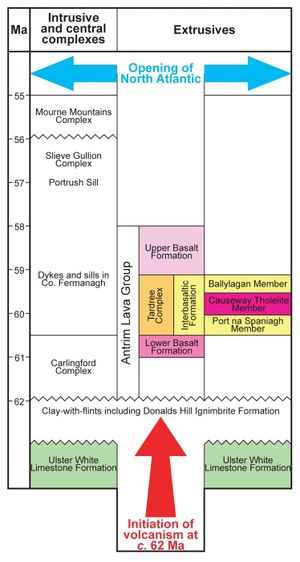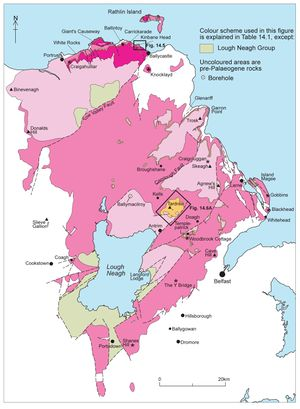Stratigraphy and chronology, Palaeogene extrusive igneous rocks, Northern Ireland
| Mitchell, W I (ed.). 2004. The geology of Northern Ireland-our natural foundation. Geological Survey of Northern Ireland, Belfast. |
M R Cooper
Stratigraphy and chronology


In the c. 10Ma time gap between the end of deposition of the Cretaceous chalk (see Cretaceous article) and the first extrusion of basalt lava of the Palaeocene Antrim Lava Group, regional uplift and erosion produced an unconformity that is exposed at the margins of the Antrim Plateau. The earliest deposit above the chalk is the Clay-with-Flints (see Cretaceous-Palaeogene (K-T) Boundary article) which had masked the river valleys and karstic scenery of the gently rolling landscape. The Clay-with-Flints deposit is overlain (P948097) by volcanic rocks, mainly basalt lava flows, of the Antrim Lava Group [1], [2]. In Northern Ireland the eruption of the Lower Basalt and Upper Basalt formations of the Antrim Lava Group (P948097) occurred in two cycles [3] which coincided with the two province-wide phases of magmatism recorded at about 59 and 55Ma respectively.
In Co. Antrim, the first evidence of volcanic activity is in the form of ash-fall deposits and small volcanic cones that resulted from localised, explosive activity and were followed by fissure eruptions of olivine tholeiite lavas of the Lower Basalt Formation (P947862 and P948097). Fractionation of the parental magma gave rise to intermediate lavas near the top of the Lower Basalt Formation. The associated decrease in volcanic activity ultimately led to the formation of the Interbasaltic Formation, which consists mainly of lateritised basalt of the Lower Basalt Formation. Deep weathering and lateritisation of basalt lava occurred during a relatively short period of sub-tropical weathering. Although frequently categorised as a time of volcanic quiescence, contemporaneous volcanism during the interbasaltic period produced the columnar basalts of the Giant’s Causeway and the silicic volcanic complex at Tardree (P947862). The second cycle is characterised by a return to the eruption of the olivine tholeiite lavas of the Upper Basalt Formation.
Volcanic activity related to the Iceland Plume continued after the extrusion of the Upper Basalt Formation (P948097). This is supported by the dating of the Portrush Sill at 57.1 ± 0.2Ma (pers. comm. Bergman, Phillips and Allen, 2003) and the presence of lava of the Upper Basalt Formation in the central volcanic complex at Slieve Gullion that is dated to 58–56Ma. Emplacement of granites of the Mourne Mountains Complex, between 56 and 55Ma (Dr I G Meighan pers. comm. 2003), was characterised by an increase in the proportion of felsic magma as a result of differentiation of crustally contaminated basic magma derived from the upper mantle [4].
Finally, in the north of Ireland there are numerous examples of dykes, dyke swarms, sills, cone sheets and ring dykes, that formed by the movement of magma along faults and bedding planes. All ages of older rocks are affected by these intrusions including the Upper Basalt Formation and the youngest granite of the Mourne Mountains Complex demonstrating that plume-related volcanism continued after 55Ma.
References
- ↑ Old, R A. 1975. The age and field relationships of the Tardree Tertiary Rhyolite Complex, County Antrim, Northern Ireland. Bulletin of the Geological Survey of Great Britain, 51, 21–40.
- ↑ Geological Survey of Northern Ireland 1997. Northern Ireland. Solid Geology (second edition). 1:250 000. (Keyworth, Nottingham: British Geological Survey).
- ↑ Lyle, P. 1980. A petrological and geochemical study of the Tertiary basaltic rocks of northeast Ireland. Journal of Earth Sciences, Royal Dublin Society, 2, 137–52.
- ↑ Meighan, I G, Fallick, A E, and McCormick, A G. 1992. Anorogenic granite magma genesis: new isotopic evidence for the southern sector of the British Tertiary Igneous Province. Transactions of the Royal Society of Edinburgh:Earth Sciences, 83, 227–33.